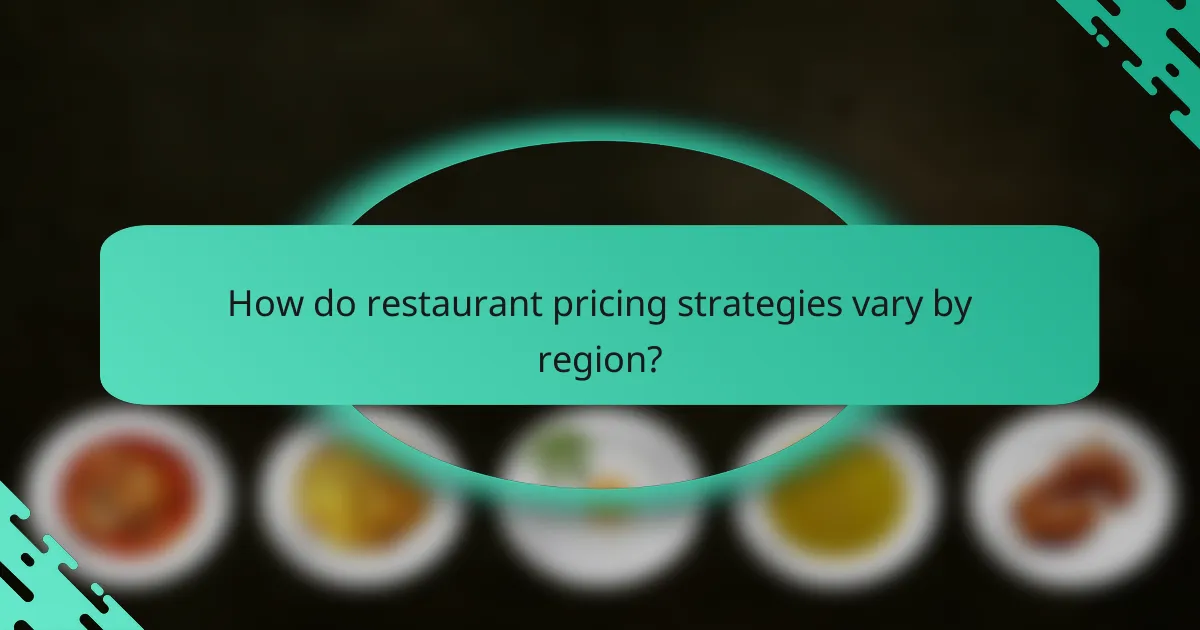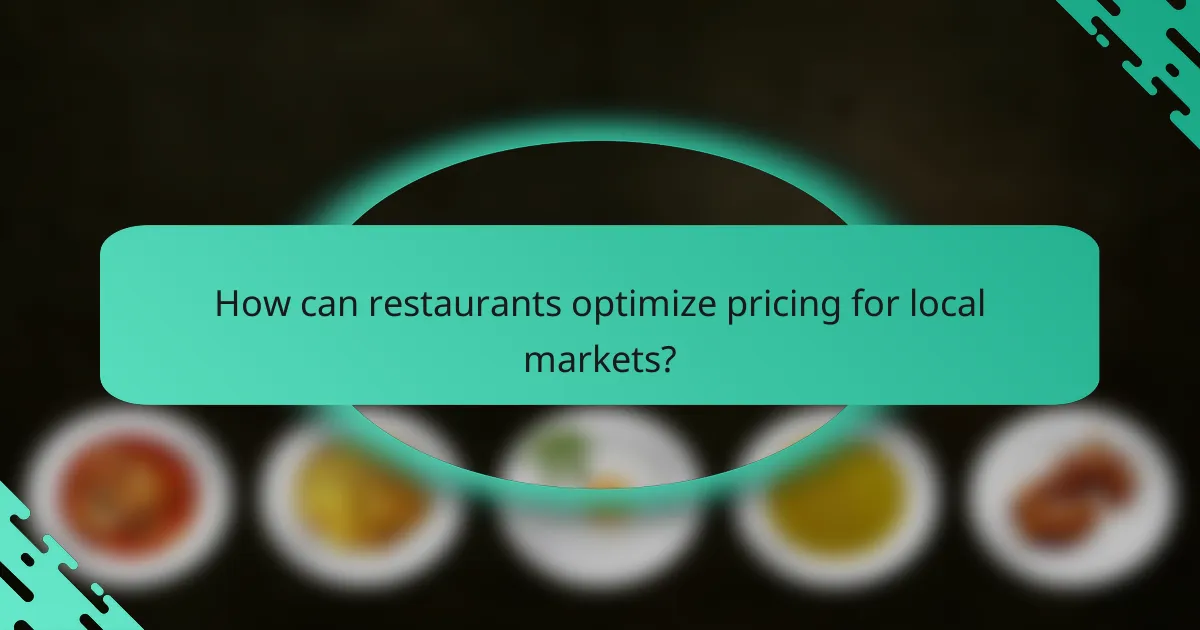Restaurant pricing is heavily influenced by location, with factors such as rent, market demand, and competition playing crucial roles in urban settings like New York City and Los Angeles. In high-demand areas, establishments often set higher prices to offset increased operational costs and cater to a diverse clientele. Conversely, suburban restaurants may focus on value-based pricing to appeal to families and budget-conscious diners, reflecting the varying economic landscapes across regions.

How does location impact restaurant pricing in New York City?
Location significantly affects restaurant pricing in New York City due to factors like rent, market demand, and competition. Restaurants in prime areas often charge higher prices to cover elevated costs and attract a larger customer base.
Higher rent costs
In New York City, rent is one of the largest expenses for restaurants, particularly in sought-after neighborhoods like Manhattan. Monthly rents can range from several thousand to tens of thousands of dollars, depending on the location, which directly influences menu prices.
Restaurants in high-rent areas may implement higher pricing strategies to offset these costs. For instance, a casual dining spot in a busy district might charge 20-30% more than a similar establishment in a less-trafficked area.
Market demand variations
Market demand fluctuates across different neighborhoods in New York City, affecting how restaurants price their offerings. Areas with high foot traffic and tourist attractions typically see greater demand, allowing restaurants to set higher prices.
Conversely, neighborhoods with lower demand may require restaurants to offer competitive pricing or discounts to attract patrons. For example, a trendy eatery in a bustling area might charge $25 for a main dish, while a similar restaurant in a quieter locale might price it around $18 to draw in customers.

What are the main factors affecting restaurant costs in Los Angeles?
The main factors affecting restaurant costs in Los Angeles include labor costs, ingredient sourcing, and overhead expenses. Understanding these elements is crucial for restaurant owners to manage their budgets effectively and maintain profitability in a competitive market.
Labor costs
Labor costs in Los Angeles are typically higher than in many other regions due to the city’s minimum wage laws and the cost of living. As of 2023, the minimum wage in Los Angeles is set at $16.78 per hour, which can significantly impact overall payroll expenses for restaurants.
Additionally, restaurants must consider benefits, overtime, and training costs when calculating labor expenses. Efficient scheduling and cross-training staff can help mitigate these costs while ensuring adequate service levels.
Ingredient sourcing
Ingredient sourcing plays a vital role in determining restaurant costs in Los Angeles. The city offers a diverse range of suppliers, but prices can vary widely based on quality, seasonality, and sourcing location. Restaurants often face higher costs for organic or locally sourced ingredients, which can appeal to health-conscious consumers.
To manage ingredient costs, restaurant owners should establish relationships with multiple suppliers and consider seasonal menus that utilize locally available produce. This strategy can help reduce costs while maintaining menu appeal and freshness.

How do restaurant pricing strategies vary by region?
Restaurant pricing strategies differ significantly by region due to factors like local competition, cost of living, and customer expectations. Urban areas often see competitive pricing, while suburban regions may adopt value-based pricing to attract families and budget-conscious diners.
Competitive pricing in urban areas
In urban settings, restaurants frequently engage in competitive pricing to attract a diverse clientele. This strategy involves setting prices based on what nearby establishments charge, often leading to lower margins but higher customer volume. For instance, a mid-range restaurant in a city might price entrees between $15 and $30, depending on the competition.
To succeed with competitive pricing, restaurants should regularly monitor local competitors and adjust their menus accordingly. Offering promotions or loyalty programs can also help maintain customer interest without significantly altering price points.
Value-based pricing in suburban areas
Suburban restaurants often utilize value-based pricing, focusing on perceived value rather than strict competition. This approach allows them to set prices that reflect the quality and experience offered, which can be particularly appealing to families. For example, a family-friendly restaurant might price meals between $10 and $20, emphasizing portion size and quality ingredients.
To effectively implement value-based pricing, restaurants should highlight unique features such as local sourcing or special dietary options. Communicating the value proposition clearly can enhance customer satisfaction and loyalty, making it easier to justify higher prices compared to urban competitors.

What are the common pricing models used by restaurants?
Restaurants typically use various pricing models to set their menu prices, with fixed and dynamic pricing being the most common. Each model has its own advantages and considerations that can significantly impact profitability and customer perception.
Fixed pricing
Fixed pricing involves setting a specific price for menu items that remains constant over time. This model provides clarity for customers, as they know exactly what to expect when ordering. It is often used in casual dining establishments where predictability is valued.
One key consideration with fixed pricing is the potential for reduced flexibility in response to market changes. For example, if ingredient costs rise, restaurants may need to absorb those costs or risk losing profit margins. Establishments can benefit from regular reviews of their pricing strategy to ensure sustainability.
Dynamic pricing
Dynamic pricing allows restaurants to adjust their prices based on various factors such as demand, time of day, or special events. This model can maximize revenue during peak times while offering discounts during slower periods. For instance, a restaurant might charge higher prices during dinner hours and lower them for lunch specials.
While dynamic pricing can enhance profitability, it may also lead to customer dissatisfaction if not implemented transparently. Clear communication about pricing changes is essential to maintain trust. Restaurants should consider using technology, such as reservation systems, to effectively manage and communicate their dynamic pricing strategies.

How do seasonal trends affect restaurant pricing in Chicago?
Seasonal trends significantly influence restaurant pricing in Chicago, with fluctuations often reflecting changes in demand and customer behavior. During peak seasons, such as summer and winter holidays, restaurants may adjust their prices to capitalize on increased foot traffic and tourist activity.
Summer tourism spikes
During the summer months, Chicago experiences a surge in tourism, leading to higher demand for dining options. Restaurants often raise their prices to match this increased interest, particularly in popular areas like the Loop and River North.
For example, a casual dining establishment might see menu prices increase by 10-20% during peak tourist season. This adjustment helps restaurants maximize revenue while accommodating the influx of visitors eager to experience the city’s culinary scene.
Winter holiday promotions
In contrast, winter holidays often prompt restaurants to offer promotions and special menus to attract local patrons and tourists alike. Many establishments create festive dining experiences, which can include prix fixe menus or themed events.
While some restaurants may lower prices to encourage dining during the colder months, others may maintain or even increase prices for exclusive holiday offerings. It’s common to see a range of pricing strategies, with discounts on certain days to draw in customers during slower periods.

What role do permits play in restaurant pricing in San Francisco?
Permits significantly influence restaurant pricing in San Francisco by adding to the overall operational costs. Obtaining the necessary permits can involve substantial fees and ongoing compliance expenses, which ultimately affect menu pricing and profit margins.
Permit costs impact overhead
The costs associated with permits can vary widely, often ranging from hundreds to thousands of dollars depending on the type of establishment and its specific needs. For example, a restaurant may need health permits, signage permits, and liquor licenses, each carrying its own fee structure.
These permit costs contribute to the restaurant’s overhead, which must be factored into pricing strategies. Higher overhead can lead to increased menu prices, making it essential for restaurateurs to balance costs with customer expectations.
Regulatory compliance expenses
In addition to initial permit fees, restaurants in San Francisco face ongoing regulatory compliance expenses. These can include costs for inspections, renewals, and potential fines for non-compliance, which can add up over time.
For instance, maintaining health and safety standards may require regular training for staff and updates to equipment, further increasing operational costs. Restaurants must stay informed about local regulations to avoid unexpected expenses that could impact profitability.

How can restaurants optimize pricing for local markets?
Restaurants can optimize pricing for local markets by conducting thorough market research to understand customer preferences, competition, and economic conditions. Tailoring prices to reflect local demand and purchasing power ensures better alignment with consumer expectations and maximizes profitability.
Market research techniques
Effective market research techniques include surveys, focus groups, and competitor analysis. Surveys can gather direct feedback from potential customers about their willingness to pay for specific menu items, while focus groups provide deeper insights into consumer preferences and dining habits.
Competitor analysis involves examining the pricing strategies of similar restaurants in the area. This can help identify pricing trends and gaps in the market, allowing restaurants to position themselves competitively. For instance, if most local eateries charge around $15 for a burger, setting a price within the $12 to $18 range may attract customers while maintaining a healthy margin.
Additionally, utilizing online tools and platforms can enhance market research efforts. Websites that aggregate restaurant reviews and ratings can offer valuable insights into customer satisfaction and pricing perceptions, enabling restaurants to adjust their offerings accordingly.


